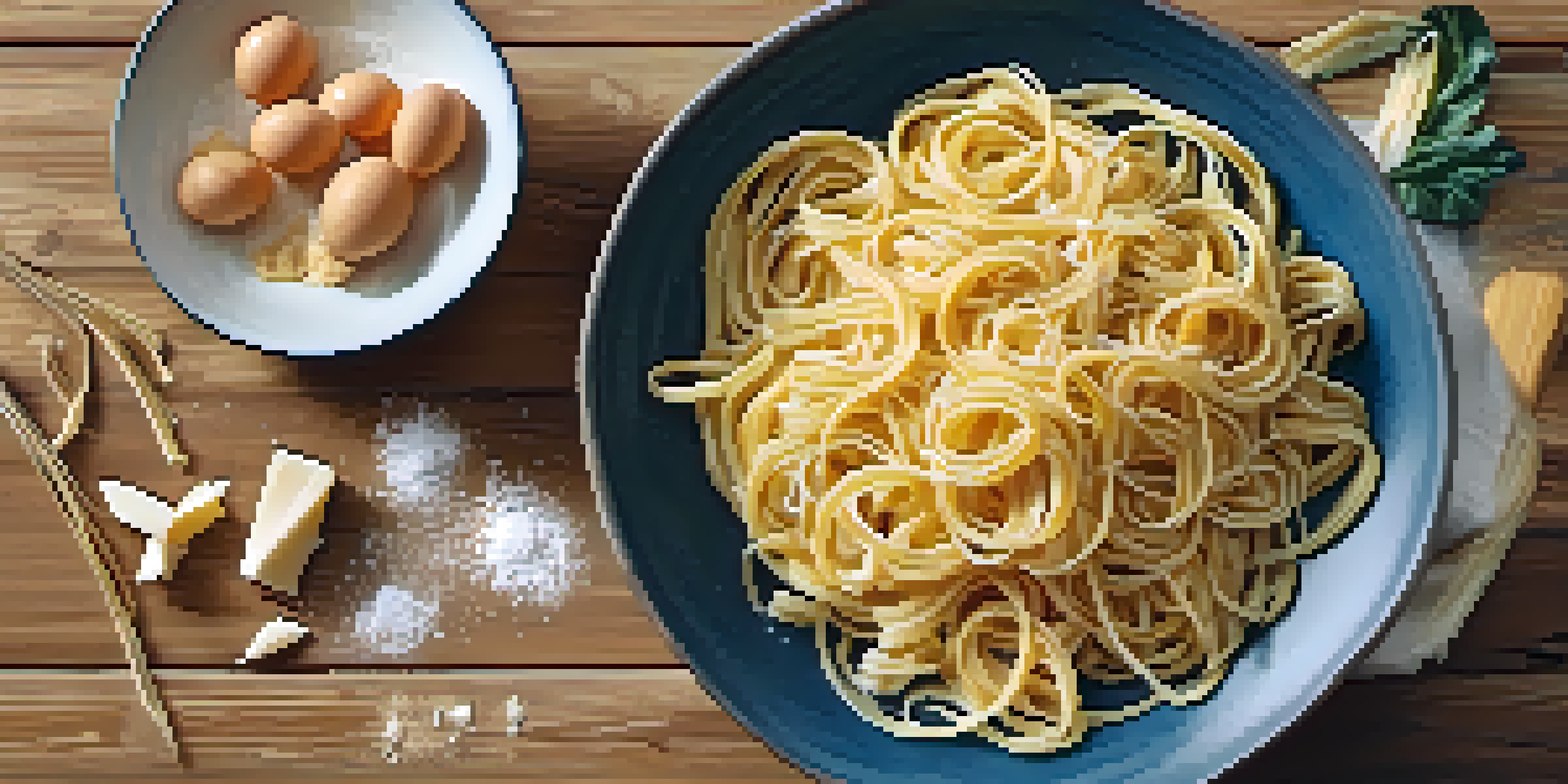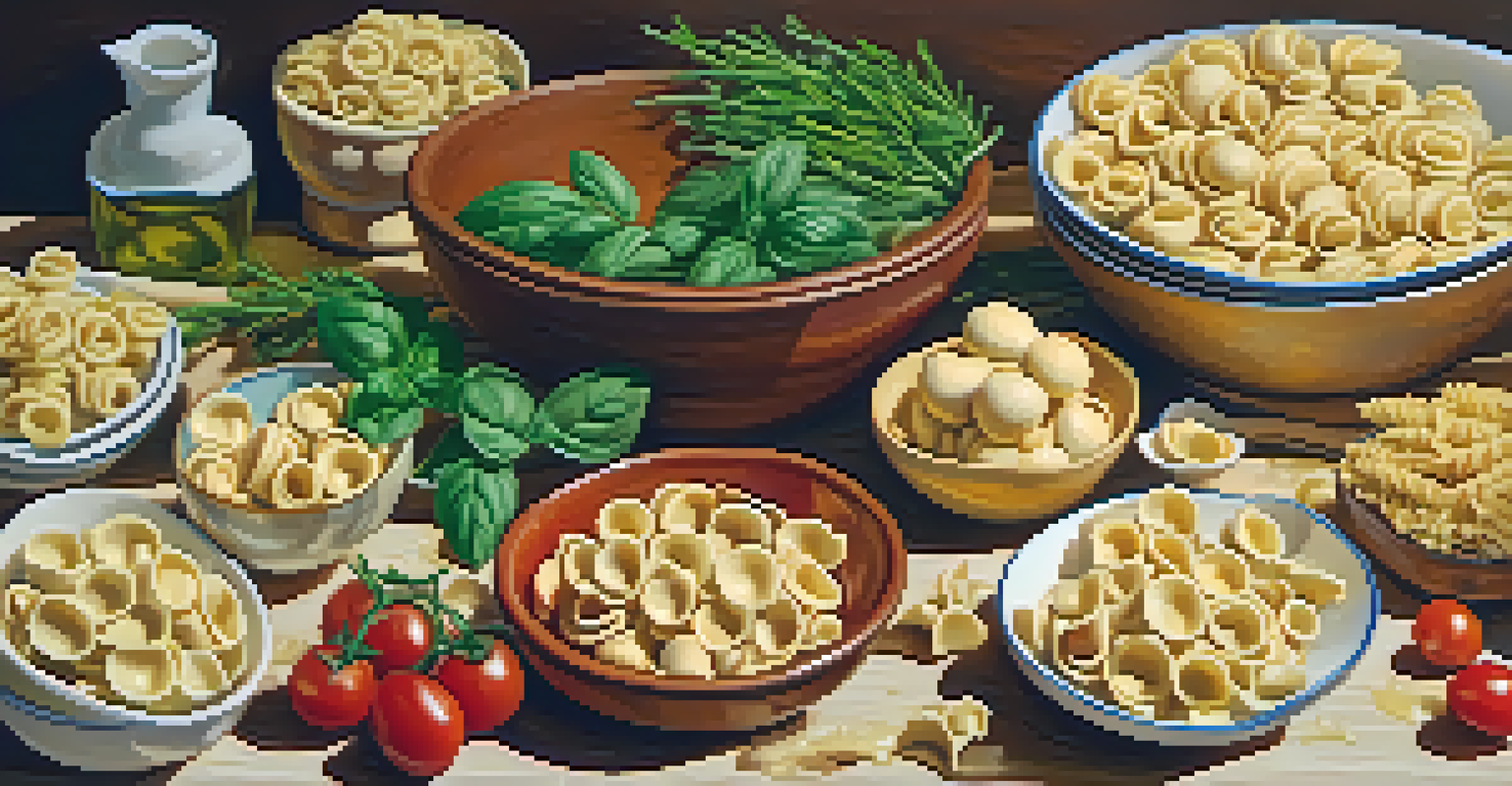Handcrafted Pasta: Skills for Luxurious Italian Cuisine

The Art of Handcrafted Pasta: A Culinary Tradition
Handcrafted pasta represents a deep-rooted tradition in Italian cuisine, where each strand is a labor of love. Unlike mass-produced varieties, handmade pasta showcases the skill and passion of the cook. It’s not just food; it’s an experience that connects you to generations of Italian heritage.
Cooking is like love. It should be entered into with abandon or not at all.
The process of crafting pasta by hand allows for creativity and personalization. You can adjust the thickness, shape, and even the flavor by incorporating ingredients like spinach or beetroot. This flexibility makes each dish uniquely yours, transforming simple meals into gourmet experiences.
When you make pasta from scratch, you're not just feeding your body; you're nourishing your soul. The tactile experience of kneading the dough and rolling it out can be therapeutic, bringing joy to your cooking journey. It’s a reminder that good food comes from heartfelt effort.
Essential Ingredients for Luxurious Pasta
Creating luxurious pasta starts with high-quality ingredients. The foundation typically includes flour, eggs, and a pinch of salt. Opting for '00' flour, known for its fine texture, elevates the final product, offering a silky mouthfeel that’s hard to beat.

Eggs add richness and color to your pasta, and using fresh, organic eggs can make a noticeable difference. Their vibrant yolks contribute not only to flavor but also to the overall appeal of the dish. Remember, the quality of ingredients directly impacts the outcome.
Handcrafted Pasta: A Culinary Art
Making pasta by hand is a rich tradition that connects you to Italian heritage and allows for creativity in every dish.
Don’t overlook the importance of salt in your dough. It adds flavor and strengthens the gluten structure, resulting in a more elastic and workable pasta. Balancing these ingredients perfectly sets the stage for your culinary masterpiece.
Kneading and Resting: The Key to Perfect Dough
Kneading is a crucial step in developing the gluten in your pasta dough. It’s where the magic happens, transforming simple ingredients into a cohesive and elastic mixture. Aim for a smooth texture, which typically takes around 8-10 minutes of kneading by hand.
The food you eat can be either the safest and most powerful form of medicine or the slowest form of poison.
After kneading, letting your dough rest is just as important. This resting period allows the gluten to relax, making it easier to roll out later. A good rule of thumb is to let it rest for at least 30 minutes, wrapped in plastic wrap to prevent it from drying out.
Think of this process as giving your dough a little 'me time.' Just like us, pasta dough benefits from a break, resulting in a more forgiving texture. The patience you invest here pays off with beautifully crafted pasta.
Rolling Techniques for Handcrafted Pasta
Rolling out your pasta is where you can truly express your style. Whether you use a traditional rolling pin or a pasta machine, the goal is to achieve an even thickness. The consistency should be thin enough to see your hand through it, ensuring a delicate bite.
If you're using a rolling pin, start from the center and work your way outwards. This technique helps keep the dough uniform. Flour your surface generously to prevent sticking, and remember to keep rotating the dough for even results.
Key Ingredients for Quality Pasta
Using high-quality ingredients like '00' flour and fresh eggs is essential for creating luxurious and flavorful pasta.
For those using a pasta machine, start with the widest setting and gradually reduce it. This method ensures a smooth, even sheet and is often less labor-intensive. Whichever technique you choose, practice makes perfect, so don’t be afraid to experiment!
Shaping Your Pasta: From Fettuccine to Ravioli
Shaping your pasta is where creativity takes center stage. From fettuccine to ravioli, the options are endless and can be tailored to suit any dish. Each shape holds sauce differently, allowing for a variety of textures and flavors in your meal.
To make fettuccine, simply roll your sheet and cut it into strips. For ravioli, place a spoonful of filling on one sheet, cover it with another, and seal the edges. This is a perfect way to use leftover ingredients or create a dish that speaks to your taste.
Don’t hesitate to explore less common shapes like orecchiette or farfalle. Each shape tells a story and adds character to your dish. Plus, mastering new shapes can be a fun challenge that elevates your pasta-making skills.
Cooking Your Pasta to Perfection
Cooking fresh pasta is a quick affair, usually taking just 2-4 minutes. Because it’s made without preservatives, it cooks faster than dried pasta. Always keep an eye on it, as overcooking can lead to a mushy texture.
A great trick is to taste the pasta a minute before you think it's done. It should be al dente, or firm to the bite, which is key for enjoying the true flavor and texture of your crafted creation. Remember, it will continue to cook slightly after draining.
Techniques for Perfect Pasta
Mastering kneading, rolling, and shaping techniques is crucial for achieving the ideal texture and presentation in your pasta dishes.
Don’t forget to reserve some pasta water before draining! This starchy water can be added to your sauce, helping it cling to the pasta and enhancing the overall flavor. It’s a simple yet effective way to elevate your dish.
Pairing Sauces: Elevate Your Handcrafted Pasta
Once your pasta is cooked, the next step is pairing it with a sauce that complements its unique taste. Light sauces, like a simple olive oil and garlic, work beautifully with delicate pasta, while heartier sauces like Bolognese hold up well with thicker shapes.
Consider creating your own signature sauce using fresh, seasonal ingredients. For example, a burst of cherry tomatoes sautéed with basil can create a fresh, vibrant topping for your pasta. This not only enhances flavor but also adds a visual appeal.

Experiment with different combinations and don’t shy away from adding protein or vegetables. The beauty of handcrafted pasta is its versatility, allowing you to create a dish that’s uniquely yours. Let your creativity flow and enjoy the delicious results!